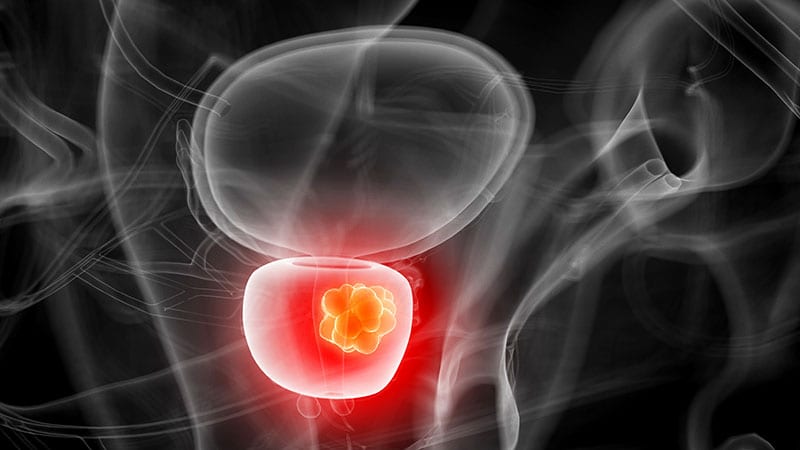TOPLINE:
At a median follow-up of 13.2 years, dose-escalated hypofractionated intensity-modulated radiation therapy led to fewer treatment failures in men with localized, intermediate-risk prostate cancer than conventional radiation therapy, although the difference was not statistically significant. However, among patients who did not receive androgen-deprivation therapy, hypofractionated radiotherapy halved the risk for treatment failure.
METHODOLOGY:
- The initial findings from the phase III randomized trial demonstrated superior cancer control with dose-escalated hypofractionated than with conventional intensity-modulated radiation therapy in patients with localized prostate cancer, at a median follow-up of 8.5 years.
- In the latest analysis, the researchers assessed patient outcomes at a median follow-up of 13.2 years to determine whether the benefit offered by hypofractionation was maintained.
- In the study, 206 patients with localized prostate cancer were randomly assigned to receive either hypofractionated (72 Gy in 2.4-Gy fractions over 6 weeks; n = 104) or conventional intensity-modulated radiation therapy (75.6 Gy in 1.8-Gy fractions over 8.4 weeks; n = 102).
- Overall, 71% of patients had intermediate-risk prostate cancer, 48% had Gleason grade group 2 prostate cancer, 90% had a prostate-specific antigen (PSA) level of ≤ 10 ng/mL, and 24% received androgen-deprivation therapy.
- The primary outcome was treatment failure, defined as PSA failure or the initiation of salvage therapy.
TAKEAWAY:
- Fewer patients experienced treatment failure with hypofractionated radiotherapy (n = 13) than with conventional radiotherapy (n = 22), although the difference was no longer statistically significant (P = .08). All patients in the hypofractionated group had PSA failure, whereas in the conventional group, 20 patients had PSA failure, and salvage therapy was initiated for two patients.
- Among patients who did not receive androgen-deprivation therapy, the 10-year failure rate was significantly lower with hypofractionated radiotherapy than with conventional radiotherapy (13% vs 26%; P = .04); this difference was not observed among those who received androgen-deprivation therapy.
- The 15-year overall survival favored hypofractionated radiotherapy (87% vs 75%) but did not reach statistical significance (P = .08). The rate of distant metastases was not statistically different between the hypofractionated radiotherapy and conventional groups (P = .2), and most events occurred beyond 9 years after starting radiotherapy.
- Late grade ≥ 2 genitourinary toxicity at 10 years was not significantly different for the hypofractionated and conventional groups (26% vs 23%; P = .5), as was gastrointestinal toxicity (10% vs 4%; P = .09).
IN PRACTICE:
“Long-term outcomes show a reduction in treatment failure associated with dose-escalated, hypofractionated [radiotherapy] in patients with low-risk and intermediate risk prostate cancer not receiving [androgen-deprivation therapy ], with similar late genitourinary and gastrointestinal toxicities,” the authors wrote.
“In the years since initial publication, hypofractionated [intensity–modulated radiation therapy] has been adopted as the standard of care due to multiple randomized controlled trials and these long-term results supporting that [hypofractionated intensity–modulated radiation therapy] provides comparable outcomes to [conventionally fractionated intensity–modulated radiation therapy], with the added benefit of convenient treatment time for patients,” they concluded.
SOURCE:
This study, led by Comron Hassanzadeh, MD, MPH, The University of Texas MD Anderson Cancer Center in Houston, was published online in Journal of Clinical Oncology.
LIMITATIONS:
This study predominantly included patients with low-risk and intermediate-risk prostate cancer, and only some patients received androgen-deprivation therapy, and hence, the findings may not be generalizable to patients with high-risk disease. Additionally, toxicity results were applicable for patients receiving intensity–modulated radiation therapy with daily image guidance, although newer techniques could have further improved tolerability.
DISCLOSURES:
This study received support in part through a Cancer Center Support grant. Three authors reported being employees of the MD Anderson Cancer Center. Some authors declared receiving research funding or honoraria and having other ties with various sources.
This article was created using several editorial tools, including AI, as part of the process. Human editors reviewed this content before publication.
Source link : https://www.medscape.com/viewarticle/can-shorter-rt-offer-long-term-benefits-prostate-cancer-2025a1000ejm?src=rss
Author :
Publish date : 2025-05-30 06:56:00
Copyright for syndicated content belongs to the linked Source.
